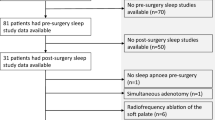Abstract
Within the last decade, adenoidectomy with partial tonsillectomy has been revived in children with obstructive sleep-disordered breathing caused by adenotonsillar hyperplasia, generating debate about remaining tonsillar tissue regrowth. The study examined potential risk factors of the regrowth. Prospective, nonrandomised, case series feasibility study of children meeting the criteria for palatine tonsils regrowth after partial tonsillectomy performed in patients with obstructive sleep-related breathing disorder was carried out. Out of 793 operated children, 294 after adenoidectomy and 373 after adenotonsillotomy were followed up for 4 years in 12-month intervals. In 27 children after adenotonsillotomy, regrowth of tonsillar tissue was observed. In 22 individuals after adenoidectomy alone, hyperplasia of palatine tonsils was noted. The children had bacterial cultures of pharyngeal smears and blood samples tested for anti-streptolysin O, C-reactive protein and total IgE. Caregivers completed a questionnaire reporting on: their child’s breathing after surgery; frequency, severity and treatment of upper respiratory tract infections; diet; family history of adenoidal and/or tonsillar hyperplasia; and history of allergy. As controls, 272 participants after adenoidectomy alone and 346 after adenotonsillotomy were examined. The amount of sugar in the diet and the incidence of upper respiratory tract infections after surgery differed between the groups of patients and controls. Other differences were insignificant. The tonsillar tissue remaining after partial tonsillectomy in children has a remarkable tendency to grow back, related to a diet abundant in sugar and numerous upper respiratory tract infections. Tonsillar regrowth was age related and occurred most frequently in individuals older than 7 years.
Similar content being viewed by others
References
Vlastos IM, Parpounas K, Economides J, Helmis G, Koudoumnakis E, Houlakis M (2008) Tonsillectomy versus tonsillotomy performed with scissors in children with tonsillar hypertrophy. Int J Pediatr Otorhinolaryngol 72:857–863. doi:10.1016/j.ijporl.2008.02.015
Koempel JA, Solares CA, Koltai PJ (2006) The evolution of tonsil surgery and rethinking the surgical approach to obstructive sleep-disordered breathing in children. J Laryngol Otol 120:993–1000. doi:10.1017/S0022215106002544
Sorin A, Bent JP, April MM, Ward RF (2004) Complications of microdebrider-assisted powered intracapsular tonsillectomy and adenoidectomy. Laryngoscope 114:297–300. doi:10.1097/00005537-200402000-00022
Helling K, Abrams J, Bertram WK, Hohner S, Scherer H (2002) Laser tonsillectomy in tonsillar hyperplasia of early childhood. HNO 50:470–478. doi:10.1007/s00106-001-0580-x
Celenk F, Bayazit YA, Yilmaz M, Kemaloglu YK, Uygur K, Ceylan A, Korkuyu E (2008) Tonsillar regrowth following partial tonsillectomy with radiofrequency. Int J Pediatr Otorhinolaryngol 72:19–22. doi:10.1016/j.ijporl.2007.09.007
Nelson LM (2003) Temperature-controlled radiofrequency tonsil reduction in children. Arch Otolaryngol Head Neck Surg 129:533–537
Breitmeier D, Wilke N, Schulz Y, Albrecht K, Wenzel V, Kleemann WJ, Panning B, Tröger HD (2005) The lingual tonsillar hyperplasia in relation to unanticipated difficult intubation: is there any relationship between lingual tonsillar hyperplasia and tonsillectomy? Am J Forensic Med Pathol 26:131–135
Lesinskas E, Drigotas M (2009) The incidence of adenoidal regrowth after adenoidectomy and its effect on persistent nasal symptoms. Eur Arch Otorhinolaryngol 266:469–473. doi:10.1007/s00405-008-0892-5
Wong L, Moxham JP, Ludemann JP (2004) Electrosurgical adenoid ablation. J Otolaryngol 33:104–106
Joshua B, Bahar G, Sulkes J, Shpitzer T, Raveh E (2006) Adenoidectomy: long-term follow-up. Otolaryngol Head Neck Surg 135:576–580. doi:10.1016/j.otohns.2006.05.027
Pagella F, Matti E, Colombo A, Giourgos G, Mira E (2009) How we do it: a combined method of traditional curette and power-assisted endoscopic adenoidectomy. Acta Otolaryngol 129:556–559. doi:10.1080/00016480802294377
Reed J, Sridhara S, Brietzke SE (2009) Electrocautery adenoidectomy outcomes: a meta-analysis. Otolaryngol Head Neck Surg 140:148–153. doi:10.1016/j.otohns.2008.11.030
Jonas NE, Sayed R, Prescott CA (2007) Prospective, randomized, single-blind, controlled study to compare two methods of performing adenoidectomy. Int J Pediatr Otorhinolaryngol 71:1555–1562. doi:10.1016/j.ijporl.2007.06.008
Reichel O, Mayr D, Winterhoff J, de la Chaux R, Hagedorn H, Berghaus A (2007) Tonsillotomy or tonsillectomy?—a prospective study comparing histological and immunological findings in recurrent tonsillitis and tonsillar hyperplasia. Eur Arch Otorhinolaryngol 264:277–284. doi:10.1007/s00405-006-0162-3
Shin SY, Choi GS, Lee KH, Kim SW, Cho JS, Park HS (2009) IgE response to staphylococcal enterotoxins in adenoid tissues from atopic children. Laryngoscope 119:171–175. doi:10.1002/lary.20046
Hajoui O, Janani R, Tulic M, Joubert P, Ronis T, Hamid Q, Zheng H, Mazer BD (2004) Synthesis of IL-13 by human B lymphocytes: regulation and role in IgE production. J Allergy Clin Immunol 114:657–663. doi:10.1016/j.jaci.2004.05.034
Ceran O, Aka S, Oztemel D, Uyanik B, Ozkozaci T (2004) The relationship of tonsillar hyperplasia and asthma in a group of asthmatic children. Int J Pediatr Otorhinolaryngol 68:775–778. doi:10.1016/j.ijporl.2004.01.007
Lindroos R (2000) Bacteriology of the tonsil core in recurrent tonsillitis and tonsillar hyperplasia—a short review. Acta Otolaryngol Suppl 543:206–208. doi:10.1080/000164800454404
Egeli E, Belli SB, Oghan F, Ozturk O (2006) Relation of isolated tonsillar hypertrophy with body mass index. ORL J Otorhinolaryngol Relat Spec 68:228–231. doi:10.1159/000092124
Kawabe J, Okamura T, Shakudo M, Koyama K, Wanibuchi H, Sakamoto H, Matsuda M, Kishimoto K, Ochi H, Yamada R (1999) Two cases of chronic tonsillitis studied by FDG-PET. Ann Nucl Med 13:277–279
Conflict of interest statement
The authors declare that they have no conflict of interest.
Author information
Authors and Affiliations
Corresponding author
Rights and permissions
About this article
Cite this article
Zagólski, O. Why do palatine tonsils grow back after partial tonsillectomy in children?. Eur Arch Otorhinolaryngol 267, 1613–1617 (2010). https://doi.org/10.1007/s00405-010-1261-8
Received:
Accepted:
Published:
Issue Date:
DOI: https://doi.org/10.1007/s00405-010-1261-8




